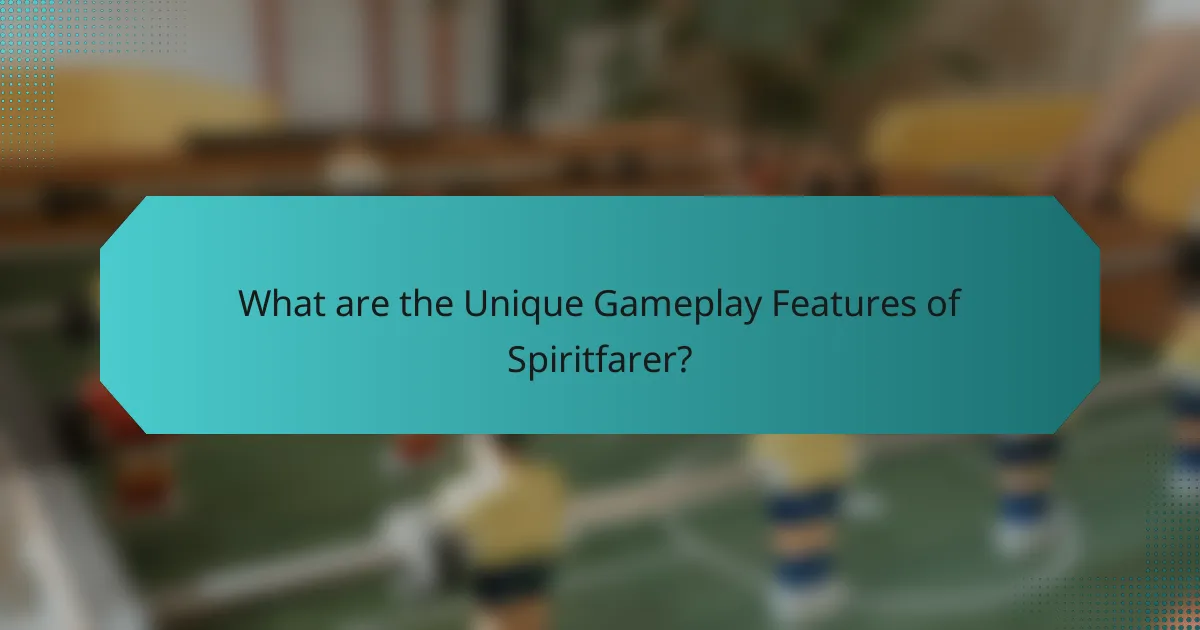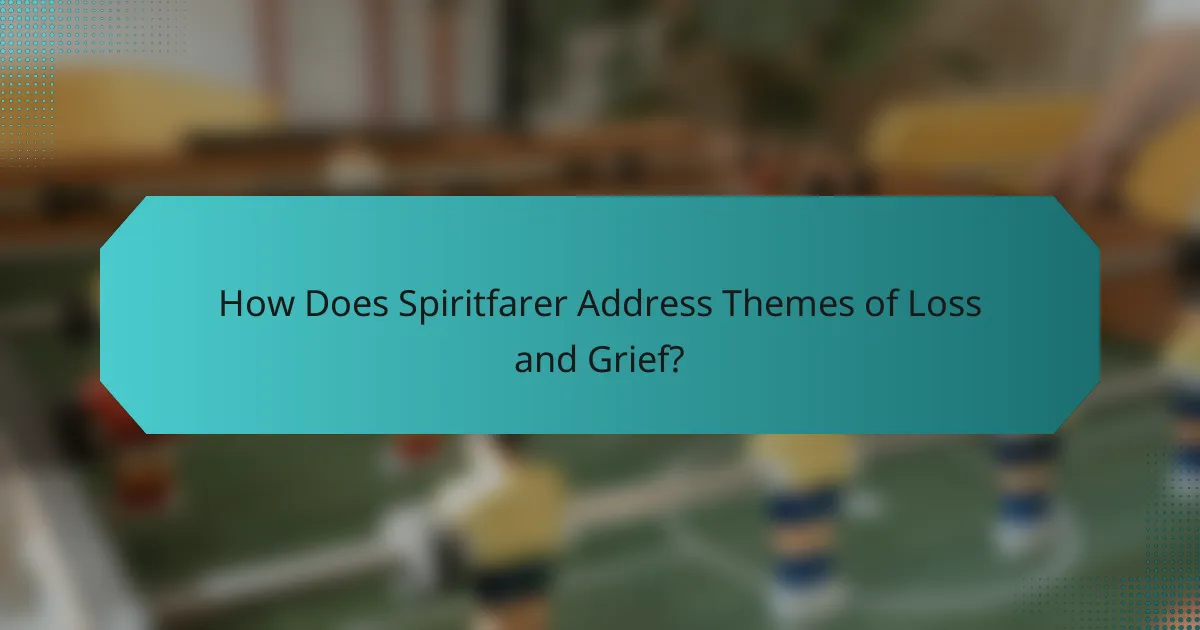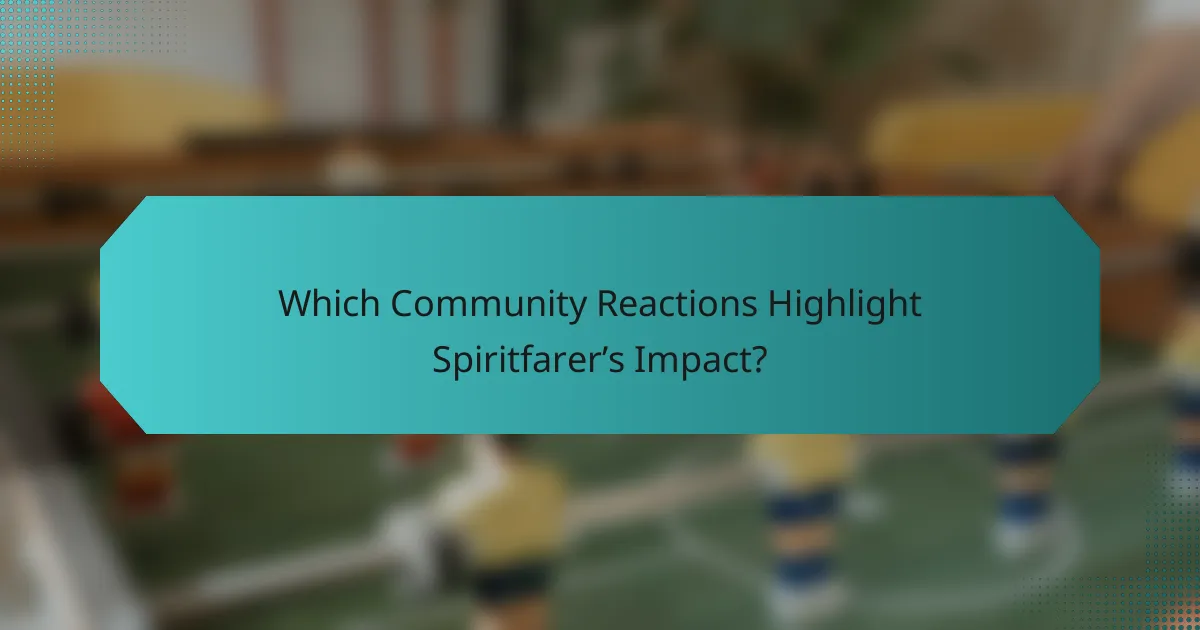Spiritfarer offers a unique blend of management gameplay and emotional storytelling, allowing players to explore themes of loss and acceptance. Players guide spirits to the afterlife while engaging in resource management and crafting. The hand-drawn art style enhances the experience, creating an immersive atmosphere that reflects the game’s poignant narrative. Community feedback highlights its emotional depth and artistic beauty, making it a significant title in gaming culture.

What are the Unique Gameplay Features of Spiritfarer?
Spiritfarer features unique gameplay elements that blend management mechanics with emotional storytelling. Players take on the role of Stella, a ferrymaster guiding spirits to the afterlife. The game emphasizes exploration, resource management, and crafting, allowing players to build and upgrade their boat, gather materials, and cook meals for spirits. A distinctive aspect is the emotional depth, as players develop relationships with spirits, addressing themes of loss and acceptance. The hand-drawn art style enhances the experience, creating an immersive atmosphere that complements the narrative.
How Does Resource Management Enhance Player Engagement?
Resource management enhances player engagement in Spiritfarer by creating a sense of purpose and achievement. Players must gather resources to build and upgrade their ships, which deepens their connection to the game’s themes of loss and care. This unique gameplay feature encourages exploration and interaction with the environment, fostering a rewarding experience. As players manage resources, they also develop relationships with spirits, further enhancing emotional engagement through meaningful storytelling.
What Role Do Building and Crafting Mechanics Play?
Building and crafting mechanics in Spiritfarer enhance gameplay by fostering emotional connections and facilitating exploration. These mechanics allow players to create and upgrade structures, which symbolize growth and change. Crafting items and resources also serves as a means to honour lost souls, reinforcing the game’s themes of loss and acceptance. The unique attribute of this system lies in its integration with the narrative, where each crafted item deepens the player’s relationship with the characters and their journeys.
How Is Exploration Integrated into the Gameplay Experience?
Exploration is seamlessly integrated into Spiritfarer’s gameplay by encouraging players to navigate a beautifully crafted world. Players discover new islands, gather resources, and interact with spirits, enhancing the emotional depth of the journey. The game’s open-world design allows for organic exploration, fostering connections with characters and themes of loss. Unique attributes, such as the diverse environments and the significance of each spirit, enrich the experience, making exploration vital to both gameplay and narrative progression.

How Does Spiritfarer Address Themes of Loss and Grief?
Spiritfarer effectively addresses themes of loss and grief through its narrative and gameplay mechanics. The game allows players to guide spirits to the afterlife, fostering emotional connections and providing a space for reflection.
Players engage in meaningful interactions with characters, each representing different aspects of grief, such as acceptance and remembrance. This unique attribute enhances the player’s understanding of the grieving process.
The artistic direction complements these themes with a hand-drawn aesthetic, creating a serene environment that encourages contemplation. The game’s music further deepens the emotional experience, reinforcing the feelings of loss and hope.
Through these elements, Spiritfarer creates a poignant exploration of mortality, helping players process their own experiences with loss.
What Emotional Narratives Are Weaved Through Character Interactions?
Spiritfarer intricately weaves emotional narratives through character interactions, highlighting themes of loss and acceptance. Each spirit embodies unique stories that reflect personal journeys of grief, love, and closure. The gameplay fosters deep connections, encouraging players to engage with each character’s past and emotional state. This engagement enhances the overall narrative, making the experience profoundly impactful. The artistic direction complements these themes, using visual storytelling to evoke empathy and understanding. As a result, players navigate not just a game, but a heartfelt exploration of life and afterlife.
How Do Farewells Contribute to the Overall Experience?
Farewells in Spiritfarer enhance the emotional depth of the gameplay experience. They signify closure and the acceptance of loss, reinforcing the game’s themes. Each farewell moment allows players to reflect on relationships built throughout the journey. This emotional resonance contributes to a more meaningful narrative and artistic direction, creating a lasting impact on players.
What Cultural Perspectives on Loss Are Reflected in the Game?
Spiritfarer reflects diverse cultural perspectives on loss through its narrative and gameplay. The game incorporates various mythologies and traditions surrounding death, emphasizing the importance of closure and remembrance. For example, characters represent different cultural backgrounds, each with unique rituals and beliefs about the afterlife. This diversity enriches the player’s understanding of loss, showcasing how different societies honour their deceased loved ones. Additionally, the gameplay mechanics encourage players to engage with these themes by building relationships and helping spirits transition, reinforcing the universal nature of grief while respecting individual cultural practices.

What Artistic Direction Sets Spiritfarer Apart?
Spiritfarer stands out due to its hand-drawn art style, emotional storytelling, and unique gameplay mechanics. The game explores themes of loss and acceptance while allowing players to build relationships with spirits. Its artistic direction emphasizes warmth and tranquility, creating an immersive experience. The combination of these elements fosters a profound connection with players, making Spiritfarer a memorable journey through grief and companionship.
How Do Visual Styles and Animation Techniques Enhance Storytelling?
Visual styles and animation techniques significantly enhance storytelling in Spiritfarer by creating an emotional connection. The hand-drawn art style evokes nostalgia, while fluid animations bring characters to life, illustrating themes of loss and transition. This artistic direction complements gameplay, allowing players to engage deeply with the narrative. For instance, character animations reflect their emotions, reinforcing the impact of their journeys. Overall, these elements work together to create a rich, immersive experience that resonates with players.
What Role Does Music Play in Creating Atmosphere?
Music plays a crucial role in creating atmosphere in Spiritfarer by enhancing emotional depth and player immersion. The game’s soundtrack, composed by Max LL, features a blend of orchestral and folk elements that reflect themes of loss and transition. Each musical piece is carefully crafted to evoke specific feelings, guiding players through poignant moments in the narrative. The integration of music with gameplay mechanics, such as during interactions with characters and exploration, reinforces the emotional weight of the story. Overall, music significantly enriches the player’s experience, making the themes more impactful.
How Are Color Palettes Used to Convey Emotion?
Color palettes in Spiritfarer effectively convey emotion by using distinct hues that reflect themes of loss and transition. Warm colors evoke comfort and nostalgia, while cooler tones symbolize sadness and introspection. Each character’s journey is visually represented through their associated colors, enhancing the emotional depth of gameplay. For instance, the vibrant palette during joyful moments contrasts sharply with muted shades during scenes of farewell, reinforcing the game’s exploration of grief. This intentional use of color not only enriches the artistic direction but also deepens player engagement with the narrative.

Which Community Reactions Highlight Spiritfarer’s Impact?
Community reactions to Spiritfarer emphasize its emotional depth and artistic beauty. Players highlight the game’s unique approach to themes of loss and the meaningful interactions with spirits. The hand-drawn art style and soothing soundtrack contribute significantly to its impact, creating an immersive experience. Many share personal stories of how the game resonated with their own experiences of grief and acceptance, reinforcing its emotional significance in gaming culture.
What Are Common Player Interpretations of the Game’s Themes?
Players often interpret the themes of Spiritfarer as reflections on loss and acceptance. The game highlights the emotional journey of helping spirits transition to the afterlife, emphasizing the importance of closure. Players connect deeply with the characters, each representing unique stories of grief and love. The artistic direction enhances these themes through vibrant visuals and soothing music, creating an immersive experience that resonates with personal experiences of loss.
How Has Spiritfarer Influenced Other Indie Games?
Spiritfarer has significantly influenced other indie games through its innovative gameplay, emotional themes, and artistic style. Its unique blend of management mechanics and narrative depth has inspired developers to explore similar themes of loss and connection.
Many indie games now incorporate emotional storytelling, focusing on personal journeys and relationships, much like Spiritfarer. The hand-drawn art style and serene atmosphere have set a benchmark for visual presentation in the indie scene, encouraging others to prioritise aesthetic quality.
Additionally, Spiritfarer’s approach to player agency and choice has prompted indie developers to create more immersive experiences. The emphasis on community and care resonates throughout the indie landscape, fostering a trend toward games that prioritise emotional engagement over traditional gameplay mechanics.

What Best Practices Can Enhance the Spiritfarer Experience?
To enhance the Spiritfarer experience, players should focus on exploration, character interactions, and resource management. Engaging deeply with the narrative adds emotional weight, while crafting and upgrading facilities improves gameplay efficiency.
Prioritise these best practices:
1. Explore diverse islands to gather resources.
2. Build and upgrade facilities for better character support.
3. Foster relationships with spirits through meaningful dialogue.
4. Complete quests to unlock new story elements.
5. Utilise cooking to boost spirits’ moods and abilities.
How Can Players Maximise Resource Management Strategies?
Players can maximise resource management strategies in Spiritfarer by prioritising efficient gathering, crafting, and upgrading. Focus on building relationships with spirits to unlock unique abilities that enhance resource collection. Utilise the ship’s layout to optimise space for storage and production. Regularly upgrade your ship to access new regions with diverse resources. Balancing exploration with resource management ensures a steady supply of materials for crafting and fulfilling spirit requests.
What Tips Can Improve Character Relationship Development?
To improve character relationship development in Spiritfarer, focus on engaging storytelling, meaningful interactions, and emotional depth. Building relationships involves understanding each character’s backstory and motivations.
1. Prioritise dialogue choices that resonate with characters’ emotions.
2. Engage in side quests that reveal more about each character.
3. Use the boat-building mechanic to create shared experiences.
4. Foster moments of reflection and connection through unique events.
These strategies enhance the gameplay experience by deepening player empathy and connection to the characters.
Which Common Mistakes Should Players Avoid?
Players should avoid common mistakes like neglecting character interactions, overlooking resource management, and rushing through the story. Engaging with characters deepens emotional connections and enhances gameplay. Efficient resource management is crucial for building and upgrading your boat. Taking time to explore the narrative allows players to fully appreciate the themes of loss and artistic direction.